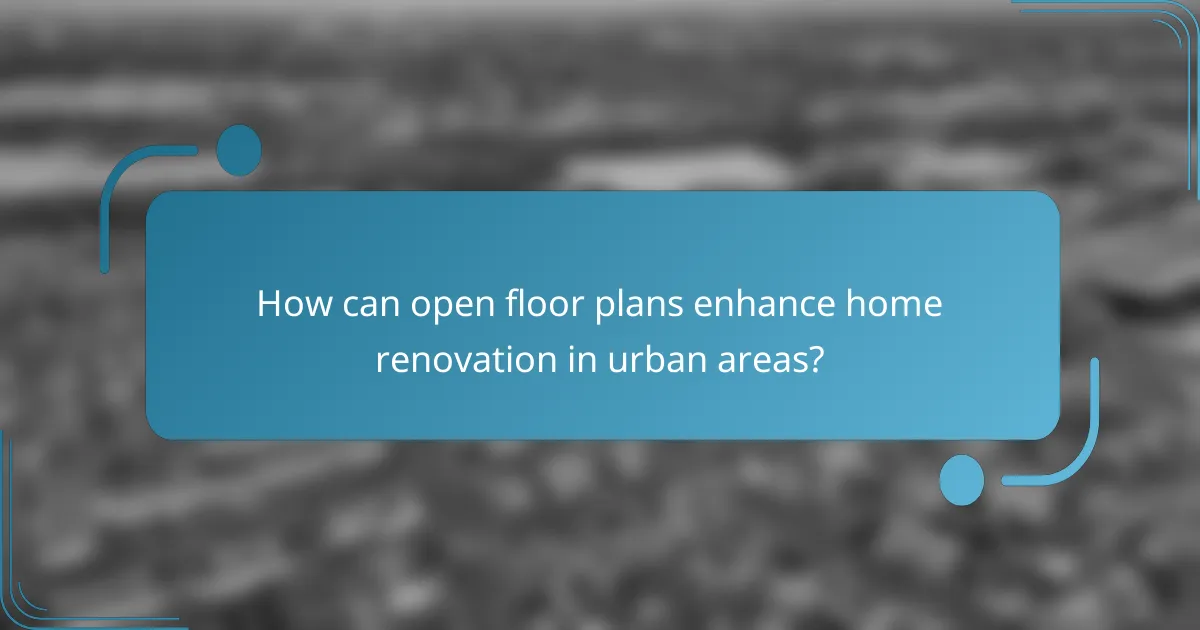Open floor plans are a popular choice in home renovation, particularly in urban settings, as they maximize space and foster a welcoming environment. By removing unnecessary walls, these designs enhance the flow and functionality of smaller living areas, while also promoting a sense of togetherness. However, homeowners must carefully consider the challenges and strategies for effectively utilizing space to maintain both aesthetics and practicality.

How can open floor plans enhance home renovation in urban areas?
Open floor plans can significantly enhance home renovation in urban areas by maximizing space and creating a more inviting atmosphere. These designs eliminate unnecessary walls, allowing for better flow and functionality in smaller living spaces.
Improved space utilization
Open floor plans make better use of available space, especially in urban homes where square footage is often limited. By removing walls, homeowners can create multifunctional areas that serve various purposes, such as combining the kitchen, dining, and living areas into one cohesive space.
Consider using furniture that can serve multiple functions, like a dining table that doubles as a workspace. This approach not only optimizes space but also enhances the overall utility of the home.
Increased natural light
With fewer walls obstructing light, open floor plans allow for more natural light to flow throughout the home. This can make spaces feel larger and more welcoming, which is particularly beneficial in urban settings where buildings may be closely packed.
To maximize natural light, consider using large windows or glass doors that connect indoor spaces to outdoor areas. This not only brightens the home but also creates a seamless transition between the inside and outside.
Enhanced social interaction
Open floor plans promote social interaction by creating a communal atmosphere where family and friends can gather. This layout encourages conversation and engagement, making it ideal for entertaining guests.
When renovating, think about how the layout can facilitate gatherings. For instance, placing seating areas near the kitchen can allow hosts to interact with guests while preparing meals.
Flexible furniture arrangements
Open floor plans offer flexibility in furniture arrangements, allowing homeowners to easily reconfigure spaces as needs change. This adaptability is particularly useful in urban homes where lifestyle demands may shift over time.
Utilize modular furniture that can be moved or reconfigured to suit different occasions. For example, lightweight chairs and tables can be rearranged for a casual gathering or a formal dinner, providing versatility without the need for extensive renovations.

What are the design impacts of open floor plans?
Open floor plans significantly influence home design by creating a seamless flow between spaces, enhancing both functionality and aesthetics. They promote a sense of togetherness while allowing for versatile use of space, but they also come with specific challenges that homeowners should consider.
Modern aesthetic appeal
Open floor plans are often associated with a contemporary design ethos that emphasizes minimalism and simplicity. This layout allows for a cohesive look, where different areas of the home can be visually connected through consistent color schemes and materials.
To achieve a modern aesthetic, consider using large windows to maximize natural light, and choose furniture that complements the open space without overcrowding it. Neutral tones can enhance the feeling of spaciousness while adding pops of color through decor can create focal points.
Perceived spaciousness
One of the main advantages of open floor plans is the perception of increased space. By removing walls, these designs allow for unobstructed sightlines, making areas feel larger and more inviting. This can be particularly beneficial in smaller homes or apartments.
When designing an open space, use area rugs to define different zones, such as living and dining areas, without the need for physical barriers. Additionally, high ceilings can amplify this effect, making the space feel even more expansive.
Challenges with noise control
While open floor plans promote interaction, they can also lead to noise issues, as sounds travel freely between areas. This can be problematic in homes with multiple activities occurring simultaneously, such as cooking, watching television, or entertaining guests.
To mitigate noise, consider incorporating sound-absorbing materials like carpets, curtains, and upholstered furniture. Strategically placing bookshelves or plants can also help break up sound waves and create a more peaceful environment.

What are the best practices for utilizing space in open floor plans?
To effectively utilize space in open floor plans, focus on creating distinct areas that serve different functions while maintaining a cohesive flow. This can be achieved through strategic zoning, multifunctional furniture, and visual cues that define spaces without physical barriers.
Strategic zoning with furniture
Strategic zoning involves arranging furniture to delineate different areas within an open floor plan. For example, a sofa can create a living area, while a dining table can define the eating space. Consider using furniture that complements each zone’s purpose while ensuring easy movement between areas.
When zoning, think about the scale and proportion of your furniture. Large pieces can dominate a space, so balance them with smaller items or open shelving to maintain an airy feel. Aim for a layout that encourages interaction while allowing for privacy when needed.
Incorporating multifunctional elements
Multifunctional furniture is essential in maximizing space efficiency in open floor plans. Items like sofa beds, extendable dining tables, or storage ottomans can serve multiple purposes, reducing clutter and enhancing usability. This approach is particularly beneficial in smaller homes where every square foot counts.
When selecting multifunctional elements, prioritize quality and design. Choose pieces that fit seamlessly into your decor while providing practical benefits. For instance, a stylish coffee table with hidden storage can keep your living area organized without sacrificing aesthetics.
Using area rugs for definition
Area rugs are an effective tool for defining spaces within an open floor plan. By placing rugs under furniture, you can visually separate areas such as the living room and dining space. This not only adds warmth but also helps anchor each zone, making the layout feel intentional.
When choosing rugs, consider size and color. A larger rug can unify a seating area, while contrasting colors can highlight different zones. Ensure the rug complements the overall design theme of your home to maintain a cohesive look throughout the space.

What are the costs associated with open floor plan renovations?
The costs for open floor plan renovations can vary widely based on factors such as location, size, and the extent of the changes. Generally, homeowners can expect to spend anywhere from low tens of thousands to over a hundred thousand dollars, depending on the complexity of the project.
Average renovation costs in major cities
In major cities like New York, Los Angeles, and Chicago, open floor plan renovations typically range from $30,000 to $150,000. For instance, in New York City, the costs can be on the higher end due to labor and material expenses, while cities like Atlanta may offer more affordable options, starting around $20,000.
It’s essential to get multiple quotes from contractors in your area to understand the local market rates and ensure you are getting a fair price for your renovation.
Factors affecting pricing
Several factors influence the pricing of open floor plan renovations. The size of the area being renovated plays a significant role; larger spaces generally incur higher costs due to increased materials and labor. Additionally, the complexity of the design, such as the need to relocate plumbing or electrical systems, can significantly impact the overall budget.
Other considerations include the quality of materials chosen, the contractor’s experience, and any necessary permits or inspections required by local regulations, which can add to the total expense.
Potential ROI on open floor plans
Investing in an open floor plan can yield a positive return on investment (ROI), often ranging from 50% to 80% of the renovation costs upon resale. Homebuyers frequently seek open layouts for their modern appeal and functionality, which can make your property more attractive in a competitive market.
However, it’s crucial to consider the neighborhood and market trends; in some areas, traditional layouts may still be preferred, potentially affecting the ROI. Consulting with a real estate professional can provide insights into the best renovation strategies for maximizing value in your specific location.

What are the prerequisites for a successful open floor plan renovation?
Successful open floor plan renovations require careful planning, structural assessments, and adherence to local regulations. Understanding these prerequisites can help ensure a smooth renovation process and optimal use of space.
Structural assessment requirements
Before starting an open floor plan renovation, a structural assessment is crucial to determine which walls can be removed or altered. Load-bearing walls must be identified, as their removal may require additional support, such as beams or columns.
Engaging a qualified structural engineer can provide insights into the feasibility of your design. They can also help estimate costs for any necessary reinforcements, which typically range from a few hundred to several thousand dollars, depending on the complexity of the project.
Permits and regulations
Obtaining the necessary permits is essential for any open floor plan renovation. Local building codes often dictate what changes can be made, especially concerning structural modifications and safety standards.
Check with your local municipality for specific regulations, as requirements can vary widely. In many areas, you may need to submit plans and pay fees that can range from a few dozen to several hundred dollars. Failing to secure the proper permits can lead to fines and complications during the renovation process.

How do open floor plans compare to traditional layouts?
Open floor plans eliminate walls between key living spaces, promoting a sense of spaciousness and flow. In contrast, traditional layouts often feature distinct rooms, which can enhance privacy and reduce noise but may feel more confined.
Pros and cons of open floor plans
Open floor plans offer several advantages, including improved natural light and better social interaction among family members. These layouts can make a home feel larger and more inviting, which is appealing for gatherings and entertaining.
However, there are downsides to consider. Noise can travel more easily in open spaces, making it challenging to maintain privacy or quiet in certain areas. Additionally, the lack of defined spaces may complicate furniture arrangement and decor choices.
When deciding between an open floor plan and a traditional layout, think about your lifestyle and how you use your space. If you frequently host guests or enjoy a communal atmosphere, an open layout may suit you. Conversely, if you value quiet and separation, a traditional design might be preferable.







